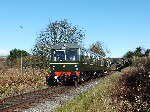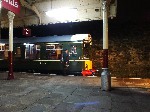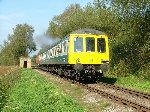Railcar of the Year 2017
Congratulations to the winner of the Railcar of the Year award:Class 105 Sc51485/E56121.
The Nominations
 Class 104 M50455/M50517 (East Lancashire Railway): The first time a Class 104 had been nominated for the award, a dozen of this class entered preservation in the early 1990's, however there had never been more than four vehicles in service at any one time due to their unfortunate design causing rampant body corrosion. They had not been doing so well recently with just a single set (at the Llangollen Railway) available for visitors and enthusiasts to sample. However that changed this year with the return to service of East Lancs based "power twin" set M50455/M50517. Originally preserved at the Churnet Valley Railway and restored between 1992 and 2004, ten good years of service and a relocation to the ELR followed before serious bodywork repairs were required again and the set withdrawn for repairs. The set was nominated for the dedication of a small restoration team and owner in getting the two vehicles bodily overhauled during a three year period. The DMBS (M50455) was particularly worthy of mention as it received the greater amount of work, and the final finish is uncompromising. It has received (amongst other items) a whole new cab front and is now the only Class 104 running in preservation to represent their "plated over" or plain front end as carried by the class from the 1970's through to their withdrawal.
Class 104 M50455/M50517 (East Lancashire Railway): The first time a Class 104 had been nominated for the award, a dozen of this class entered preservation in the early 1990's, however there had never been more than four vehicles in service at any one time due to their unfortunate design causing rampant body corrosion. They had not been doing so well recently with just a single set (at the Llangollen Railway) available for visitors and enthusiasts to sample. However that changed this year with the return to service of East Lancs based "power twin" set M50455/M50517. Originally preserved at the Churnet Valley Railway and restored between 1992 and 2004, ten good years of service and a relocation to the ELR followed before serious bodywork repairs were required again and the set withdrawn for repairs. The set was nominated for the dedication of a small restoration team and owner in getting the two vehicles bodily overhauled during a three year period. The DMBS (M50455) was particularly worthy of mention as it received the greater amount of work, and the final finish is uncompromising. It has received (amongst other items) a whole new cab front and is now the only Class 104 running in preservation to represent their "plated over" or plain front end as carried by the class from the 1970's through to their withdrawal.
 Class 105 Sc51485/E56121 (East Lancashire Railway): Again, this was the first time a Class 105, or "Cravens", had been put up for the award. Those in the railcar community will need no explanation as to why this 2-car set was nominated. Representing two thirds of the overall preserved Class 105 fleet (there is only one other vehicle in existence), this set was preserved by the West Somerset Railway in 1982 and was worked hard for 15 years with little major restoration or overhaul work carried out to safeguard its long term future. By the mid 1990's it was withdrawn from service in very poor condition and was contaminated with lethal asbestos insulation. Disposal was the preferred option of the West Somerset, which was a big problem for the movement as this was the only complete Cravens set left, so was one of the "Holy Grail" sets of historically significant DMU's. Rescued by members of the East Lancs Railway, it was moved there in 1997 and was stripped of asbestos leaving corroded and stripped out shells as a starting point for what would become a truly mammoth restoration. Extraordinary in nature, the restoration back to as built 1950's condition was completed without grant funding over 20 years using dedicated graft and determination. A comprehensive "nut and bolt" rebuild, the body and interiors were transformed from almost nothing, with every surviving component restored and everything missing faithfully reproduced. It was nominated this year of course due to the set reaching completion and making its first runs post-overhaul during November, and sending ripples throughout the movement in the process.
Class 105 Sc51485/E56121 (East Lancashire Railway): Again, this was the first time a Class 105, or "Cravens", had been put up for the award. Those in the railcar community will need no explanation as to why this 2-car set was nominated. Representing two thirds of the overall preserved Class 105 fleet (there is only one other vehicle in existence), this set was preserved by the West Somerset Railway in 1982 and was worked hard for 15 years with little major restoration or overhaul work carried out to safeguard its long term future. By the mid 1990's it was withdrawn from service in very poor condition and was contaminated with lethal asbestos insulation. Disposal was the preferred option of the West Somerset, which was a big problem for the movement as this was the only complete Cravens set left, so was one of the "Holy Grail" sets of historically significant DMU's. Rescued by members of the East Lancs Railway, it was moved there in 1997 and was stripped of asbestos leaving corroded and stripped out shells as a starting point for what would become a truly mammoth restoration. Extraordinary in nature, the restoration back to as built 1950's condition was completed without grant funding over 20 years using dedicated graft and determination. A comprehensive "nut and bolt" rebuild, the body and interiors were transformed from almost nothing, with every surviving component restored and everything missing faithfully reproduced. It was nominated this year of course due to the set reaching completion and making its first runs post-overhaul during November, and sending ripples throughout the movement in the process.
 Class 110 E51813/E59701/E51842 (East Lancashire Railway): The third nomination from the same railway, the East Lancs, was the unique 3-car Class 110 "Calder Valley" set. One of only two sets preserved, this is the only one in original 3-car format (the other set having lost its centre car) and was preserved at the ELR in 1990 (as a 2-car, the centre car joining it four years later). By the mid 1990's it had been largely restored to its original 1960's condition and ran for many years on the ELR before moving to the Wensleydale Railway in 2003. The following 13 years weren't kind to the unit, with high mileages, bodywork deterioration and eventual mechanical failure putting the entire set out of service and on the road to decline. The set is nominated this year for the astonishing turnaround in fortunes that has occurred over the last two years. In 2016, the 3-car set was rescued and returned by its owner to its original home the ELR, following which the full three cars within the set have each in turn been mechanically and bodily overhaulled to return them to a presentable and operational condition. What is special about this work is the sheer speed in which it has been undertaken. As far as we knew, a 3-car set had never been overhauled in such a short period and the owners deserved great credit for achieving this feat without the comprehensive use of contractors. Once again it was an example of dedication and teamwork that yielded the results. In common with both the 104 and 105 (other nominations) the target deadline was the ELR's gala in November, which this set, like the two others, debuted at.
Class 110 E51813/E59701/E51842 (East Lancashire Railway): The third nomination from the same railway, the East Lancs, was the unique 3-car Class 110 "Calder Valley" set. One of only two sets preserved, this is the only one in original 3-car format (the other set having lost its centre car) and was preserved at the ELR in 1990 (as a 2-car, the centre car joining it four years later). By the mid 1990's it had been largely restored to its original 1960's condition and ran for many years on the ELR before moving to the Wensleydale Railway in 2003. The following 13 years weren't kind to the unit, with high mileages, bodywork deterioration and eventual mechanical failure putting the entire set out of service and on the road to decline. The set is nominated this year for the astonishing turnaround in fortunes that has occurred over the last two years. In 2016, the 3-car set was rescued and returned by its owner to its original home the ELR, following which the full three cars within the set have each in turn been mechanically and bodily overhaulled to return them to a presentable and operational condition. What is special about this work is the sheer speed in which it has been undertaken. As far as we knew, a 3-car set had never been overhauled in such a short period and the owners deserved great credit for achieving this feat without the comprehensive use of contractors. Once again it was an example of dedication and teamwork that yielded the results. In common with both the 104 and 105 (other nominations) the target deadline was the ELR's gala in November, which this set, like the two others, debuted at.
 Class 116 M51131 (Battlefield Line): The final nomination, and the only nomination of the year to be of suburban high density design, was Class 116 M51131. The first Class 116 ever to be nominated, it was part of a select group of only three Class 116 power cars to survive in preservation, after the preserved fleet was decimated by an arson attack in Swansea 10 years ago. Preserved in 1994 at the Battlefield Line, M51131 has always been special for retaining its later BR Blue & Grey livery rather than being reliveried into an early colour scheme such as Green. It has spent the vast majority of its preserved life in working condition, and had flown the flag for Class 116's in the past when the majority of the rest of the preserved 116's were out of service. However body corrosion eventually caught up with it, being withdrawn in 2011 for repairs. M51131 was nominated as 2017 saw it return to service, carrying (of course!) a fresh coat of Blue & Grey following the comprehensive cosmetic repair work. The size of the volunteer team who undertake this work at the Battlefield was small, and M51131 was nominated as it is proof that quietly working away at a restoration project will yield results if perseverance is applied. M51131's return to service would not gain the same media attention as some of the higher profile restorations, which was all the more reason to see it recognised here. M51131 became the only Class 116 powercar in operational condition and meant that once again, the movement had an operating example of British Railways' own "standard" design of suburban DMU.
Class 116 M51131 (Battlefield Line): The final nomination, and the only nomination of the year to be of suburban high density design, was Class 116 M51131. The first Class 116 ever to be nominated, it was part of a select group of only three Class 116 power cars to survive in preservation, after the preserved fleet was decimated by an arson attack in Swansea 10 years ago. Preserved in 1994 at the Battlefield Line, M51131 has always been special for retaining its later BR Blue & Grey livery rather than being reliveried into an early colour scheme such as Green. It has spent the vast majority of its preserved life in working condition, and had flown the flag for Class 116's in the past when the majority of the rest of the preserved 116's were out of service. However body corrosion eventually caught up with it, being withdrawn in 2011 for repairs. M51131 was nominated as 2017 saw it return to service, carrying (of course!) a fresh coat of Blue & Grey following the comprehensive cosmetic repair work. The size of the volunteer team who undertake this work at the Battlefield was small, and M51131 was nominated as it is proof that quietly working away at a restoration project will yield results if perseverance is applied. M51131's return to service would not gain the same media attention as some of the higher profile restorations, which was all the more reason to see it recognised here. M51131 became the only Class 116 powercar in operational condition and meant that once again, the movement had an operating example of British Railways' own "standard" design of suburban DMU.
Voting Pattern
The voting pattern this year was the most straightforward of any of the awards held to date. Rather than any "jostling for position", within an hour of votes opening the four nominations settled into an order which would stay exactly the same throughout the whole month of voting. The Class 105 roared to the top position, with the Class 104 also attracting a respectable number of votes (about half of what the 105 attracted). Fellow Birmingham built product, the Class 110, also had a cluster of votes with the Class 116 attracting a handful in 4th place.
This positioning in the "league table" remained the same for the next 30 days, and the final numbers were the Class 105: 174 votes, Class 104: 55, Class 110: 29 and Class 116: 8. The Cravens set was over 100 votes above it's nearest rival, so it was a true win in every sense. A total of 266 votes were cast, quite a few less than last year, but it is still the third highest number of votes in the history of the awards.
| Place | Vehicle | Number of Votes |
| 1st | Class 105 51485/56121 | 174 |
| 2nd | Class 104 50455/50517 | 55 |
| 3rd | Class 110 51813/59701/51842 | 29 |
| 4th | Class 116 51131 | 8 |